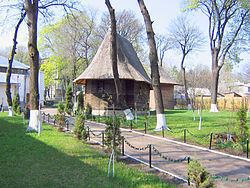Status Municipality Area 60.39 km² Local time Friday 6:51 PM | Time zone EET (UTC+2) Population 31,073 (2002) | |
 | ||
Weather 7°C, Wind N at 14 km/h, 94% Humidity | ||
Dorohoi ([doroˈhoj]) is a city in Botoșani County, Romania, on the right bank of the Jijia River, which broadens into a lake on the north.
Contents
- Map of Dorohoi 715200 Romania
- History
- 2010 Romanian floods
- Demographics
- Jews of Dorohoi
- Attractions
- Government
- References
Map of Dorohoi 715200, Romania
History
Dorohoi used to be a market for the timber and farm produce of the north Moldavian highlands; merchants from the neighboring states flocked to its great fair, held on the June 12. The settlement is first mentioned in documents from 1408, where a treaty was signed between Moldavian voievode, Alexandru cel Bun, and the King of Poland and Hungary.
Dorohoi was bombed by the Russians during World War I.
Dorohoi used to be the capital of Dorohoi County, but was degraded to a municipality when Romania lost Northern Bukovina to the Soviet Union. On July 1, 1940, units of the Romanian Army attacked local Jews in a pogrom. These military actions against the Jews were not endorsed by the Romanian Government. When the conspiracy against the Jews was discovered by the military command, troops were sent to end the abuse.
2010 Romanian floods
The northeastern town of Dorohoi witnessed deaths during the night of June 28–29 as floods rose to just over 1 metre/3.3 feet in some places. Several roads into Dorohoi remained either washed away or under water. The heavy rain that had been falling for close to a week had forecasters warning that it would continue in northeast Romania. The unusually heavy rain killed 6 people, most in the town of Dorohoi on the 29th.
Demographics
According to the census from 2011 there was a total population of 22,600 people living in this city. Of this population, 98.13% are ethnic Romanians, 1.54% ethnic Romani, 0.07% ethnic Jews and 0.02% ethnic Ukrainians.
Jews of Dorohoi
Jews first settled in Dorohoi in the 17th Century. It was set up as a Jewish Guild under Moldavia. Jews suffered here during World War I.
The Jewish population actually increased after the Holocaust as a result of refugees settling there. In 1947, there were 7,600 Jews living in Dorohoi. Following the establishment of Israel, the Jewish population of the Dorohoi steadily decreased. In 1956, there were 2,753 Jews. In 1966, there were 1,013. By 2000, there were only 49 Jews left in Dorohoi.
Attractions
In the city there is a church built by Ștefan cel Mare.
Government
The city administers three villages: Dealu Mare, Loturi Enescu and Progresul.
